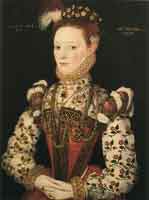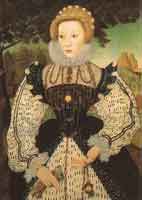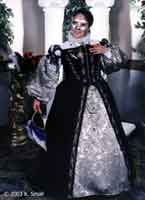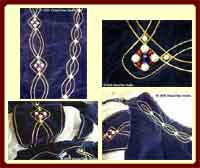 |
 |
 |
 |
 |
 |
This was my first noble's dress, made in 1996. I still wear it today, and tho it shows some wear, it is still going strong with minimal upkeep. The gown was based on two portraits, the first thought to be Lady Helena Snakeborg, Marchioness of Northampton (1569)1, the second a portrait of an Unknown Lady, originally described as being "Mary, Queen of Scots" (1560)1.
The bodice and skirt is made of dark blue cotton velveteen, with a fully boned and lined bodice. The bodice is attached in the front with hook and eyes, which is historically appropriate. The skirt currently is worn separate from the bodice, although originally it was sewn to the bodice along the back, leaving the front open. I am wearing a cotton chemise underneath, which is still in good condition today. The ruff was also my first, made of wired Christmas ribbon attached to a band with ribbons to tie it shut. The ruff is still in good condition, and I still wear it on occassion.
Both bodice and skirt is embellished with gold cording in two knotwork styles, hand couched with golden yellow thread onto the velveteen. For sparkle, I added in dark blue and red glass beads, and faux pearls. The embellishments continue on the shoulder rolls, and on the back of the bodice as well. Unlike modern manufactured garments where decorations are usually placed only in the front, a gown like this should look good when you are both coming, and going.
I am wearing a golden glass and pearl beaded pill box hat, which cannot be seen (and is currently lost). The forepart of the underskirt, and the sleeves are in a modern "gold tissue" style fabric. The feathered fan in my hand has since been eaten by my cats, but was made to match the dress.
While this was based on two portraits, and is a quality constructed garment, the fashion for the larger sleeves is apparantly inappropriate for the 1560s, despite the sleeve style shown in the Unknown Lady portrait. A new set of tight sleeves with matching forepart is in the works.
Resources:
- Tudor & Elizabethan Portraits, an Internet site "dedicated to making portraits and other works of art from the Tudor and Elizabethan era available to everyone for the purpose of research and education."
Home
Creative Blog
Kimiko Small Designs
Joan Silvertoppe's SCA Resumé
Warderobe Accounts
Brodyworke Accounts
Scriptor Arts Folium
Tudor Research
Workshops & Articles
Inspiration Gallery
Largesse
Favorite Links
About Me
Contact Me
http://www.kimiko1.com
Entire website, graphics, and text (unless otherwise stated)
© 2003-2013 Kimiko Small, All Rights Reserved


